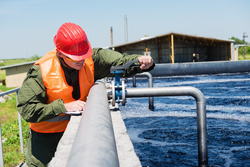 As we approach winter, it's easy to forget that last summer a drought was declared across much of England, reservoirs hit their lowest levels in 25 years, and hosepipe bans affected millions,. Water access issues were certainly headline news in summer 2022.
As we approach winter, it's easy to forget that last summer a drought was declared across much of England, reservoirs hit their lowest levels in 25 years, and hosepipe bans affected millions,. Water access issues were certainly headline news in summer 2022.
Nor are these issues going to go away., as a report from the National Drought Group underlines. Despite the fact that, for the first time in six months, September rainfall across England as a whole reached average levels, due to soils remaining drier than usual, this has made little or no difference to reservoir levels and most of the country remains in drought. Projections suggest average rainfall over winter will not be enough to prevent drought conditions in some areas next year
Increase in droughts predicted
More broadly, despite frameworks set out in the Paris Agreement , temperatures are still predicted to rise by 2.7°C above pre-industrial levels by 2100, meaning that we’re only likely to see an increase in drought conditions. As we’ve seen this summer, this makes it harder to ensure sufficient water provision, maintain water quality, and deliver all the water required for development, biodiversity, and human sanitation.
However, the use of reclaimed water could provide part of the solution, helping companies reduce the impact on the environment and help conserve clean water supplies. This is particularly true in highly water-intensive applications like industrial cooling.
A 2020 standard, BS ISO 22449-1:2020 Use of reclaimed water in industrial cooling systems sets out a basic framework for how industrial and domestic wastewater can be used in cooling systems.
Why industry has a big role to play in water preservation
Globally, around 19% of total water withdrawals are for industrial purposes. While in the UK this is slightly lower (around 12%), this still represents a significant proportion of total water use. In heavily industrialised nations, the total proportion of water used for industrial purposes is staggering (over 80% in Germany, for example). Low-income countries currently use less than 3% for industry, but this proportion is predicted to rise rapidly in the next few decades, putting pressure on supplies and potentially causing conflict between different user groups.
However, there are solutions to help address the problem. Vast quantities of water are used in industrial cooling every year (datacentres in the USA alone consume an estimated 1.7 billion litres a day), but some countries are making rapid progress in developing cooling systems that use wastewater for industrial cooling.
The business case for reducing water use
Industrial cooling is essential for the functioning of everything from chemical processing plants, power stations, and increasingly datacentres. Thanks to its availability and high heat capacity, water is most commonly used for cooling. However, given the high volume of water required, there is obviously potential for waste.
Using reclaimed water instead of freshwater for cooling can contribute to a company’s environmental targets, while also saving significant expenditure on water supply and effluent disposal.
Where companies opt to treat their industrial wastewater to remove some raw material or product prior to using the water in a cooling system, this can have the added benefit of reducing cost for the effluent stream further down the line.
The remaining barriers to using reclaimed water in cooling systems
Industrial wastewater, domestic wastewater (or a mixture of the two) can be used in cooling systems, but there are challenges to overcome before it can be used safely and effectively. One major issue is that reclaimed water can be associated with corrosion and scaling within cooling systems, and great care needs to be taken to address these potential issues.
Reclaimed water can also contain pollutants like asbestos, lead, mercury, nitrates, phosphate, sulphur, oils and petrochemicals. Many of these pollutants can be addressed, but given the obvious potential harm to human and animal life, clear processes for treatment need to be developed and followed.
The design of cooling systems is complex, and designing an effective system involves a careful balance of requirements, site-specific factors and environmental considerations. BS ISO 22449-1:2020 has been developed to help overcome these challenges.
What does BS ISO 22449-1:2020 cover?
BS ISO 22449-1:2020 provides a useful framework for using reclaimed water in industrial cooling. It sets out water quality specifications, water quantity and temperature requirements, wastewater treatment technologies for reuse and the treatment for inhibition of corrosion, scaling and biological fouling, thus removing many of the barriers to adoption.
Beyond industrial cooling applications, there are other standards that can help your business to meet the need for safe, reliable, and affordable water, whilst minimizing the adverse effects on the environment:
1. BS EN ISO 14046 Environmental management – Water footprint – Principles, requirements and guidelines. Allows all kinds of organizations (from industry to government and NGOs) the means to measure their ‘water footprint’.
2. BS EN ISO 16075:2 2020 Guidelines for treated wastewater use for irrigation projects. Designed for the agricultural industry, this standard contains guidelines for the development and execution of treated wastewater projects, including design, materials, construction, and performance.
If you have any other questions about which standard can help you reduce water use, BSI members can get in touch with the Knowledge Centre’s information experts.

 As we approach winter, it's easy to forget that last summer a drought was declared across much of England, reservoirs hit their lowest levels in 25 years, and hosepipe bans affected millions,. Water access issues were certainly headline news in summer 2022.
As we approach winter, it's easy to forget that last summer a drought was declared across much of England, reservoirs hit their lowest levels in 25 years, and hosepipe bans affected millions,. Water access issues were certainly headline news in summer 2022.